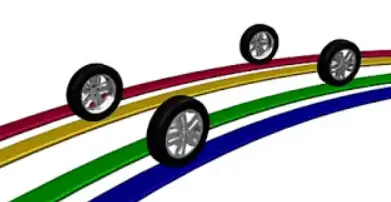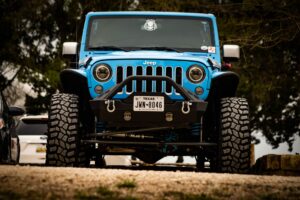When part time 4WD drive vehicles engage in 4WD mode on hard surfaces like tarmac roads or highways, there will be a difficulty in turning corners, hard to turn the steering wheel.
This is a normal phenomenon that occurs due to binding of drive lines.
Simply this occurs because the inability to spin front and rear drive shafts at different speeds when turning while transfer case engaged in 4WD mode.
In this article we’ll see how this happens in detail.
Contents
How a part time 4WD system works
Part time 4WD vehicles have 2H , 4H and 4L gears to select. On normal roads and highways we should engage in 2H.
That means only 2 wheels (normally rear wheels) propel the vehicle.
When off road conditions that we need more traction to move on, like snow , mud and dirt we engage in 4H. That means we connect the front drive shaft to the drivetrain from the transfer case by putting in 4H.
So that both front and rear axles connect from transfer and work as a single drive train.
Both front and rear axles rotate in the same RPMs. If differential lockers also engaged all the four wheels of the vehicle get an equal amount of torque and rotate at the same speeds.
This is very important for off-roading. If one or two wheels off the ground or lost their traction other wheels move the vehicle without problem.
How the four wheels run when cornering on a highway
When a vehicle takes a bend on a highway the front wheels go on a larger arc than the rear wheels.
What does that mean ? That means front wheels have to spin more distance than the rear wheels at the same time.
It means front wheels should spin more speed than rear wheels and also the outer wheel of an axle has to spin more speed than the inner wheel of the same axle.
You can see that in the following diagrams.

Is it a problem for a normal 2wd vehicle ? No. 2WD vehicles don’t have a connection between front and rear axles and also in a given axle they have a differential which will facilitate for the different speeds of two wheels.
But in part time 4wd drive vehicles, they have a problem when cornering while engaged in 4wd mode.
What happens internally on the 4WD system when cornering ?
As mentioned before, part time 4WD vehicles have a mechanical connection between front and rear axles through transfer case when engaged in 4WD mode.
Because of that what happens is when cornering, front and rear wheels try to spin at the same speed by drivetrain.
But it’s not possible on hard pavements, tarmac roads or highways. Due to high traction on wheels, wheels can’t slip.
Because of that, the extra torque again transmitted through drive shafts inversely to the transmission system.
So that, it may result in driveline binding/axle binding/ driveline wind up. This causes the jerking when cornering, hard to get a turn like symptoms when engaging in 4WD mode on highways.
Another thing is if wind up happens you will never ever be able to remove the gear from 4H to 2H in any way.
Even if you hang up on the gear it will not move due to the massive force built up in the gearbox.
If any one drives constantly in this condition it will cause serious damage to u joints, drive lines or even transmission systems.
Apart from that tyres also may tend to uneven wearing due to slipping on hard tarmac.
How to fix the wind up
What should you do to fix the wind up that happens due to engage in 4wd mode while cornering on a highway ?
In that case you have to release that excessive force built up in the drivetrain and transmission system. To do that you have two options.
One is to reverse the vehicle at the same angle of cornering for the same distance.
If you suddenly stop when you feel the tightness of steering and jerking of the vehicle, you just have to reverse the vehicle slowly along the same way in that bend until releasing the wind up.
Then you should disengage the 4WD mode.
Next thing is you have to keep one side of the vehicle on a low traction surface like sand/ mud / grass and other side on the tough surface like turmac road and you have to pull it allowing wheels to spin at different speeds and release the wind up.
Then it will allow you to move the gear lever.
Why is this not happening in 4WD vehicles on off-roading trails ?
That is because that extra torque is release constantly by tyre slipping on ground.
That’s why it is advised to engage in 4WD mode only in conditions wheels need more traction to move on.
Wheels need more traction means those places are slippery or loose to spin wheels on that surface.
So it’s not a problem if wheels need to spin at different speeds it can happen.
Another thing is that on off roads we don’t drive at high speeds.so wheels don’t need much different wheel spinning speeds on most of the terrains.
But the axle differential should also be locked only when it’s necessary.
Otherwise it will be very hard to take a turn on your 4WD vehicle even on off-roading trails.
Why AWD don’t have this problem
The full time 4WD or all wheel drive systems work in a different way. As I discussed in a previous article they have a center differential to maintain the connection between front and rear axles.
By that center differential, engine torque is distributed accordingly into front and rear axles.
When cornering on a highway the different speeds of the axles are maintained by this center differential.
Another thing is modern AWD vehicles have computer units to control this AWD system.
That means this system along with the ABS and traction control systems work together to transmit engine torque to the wheels which has most traction.
They work with advanced technologies so they don’t have this binding problem at all.
Conclusion
This is how things are happening. So if you are driving a part time 4wd vehicle you should be careful about choosing the 4wd mode only when you need more traction to move.
On dry tarmac roads, dry highways like road conditions are not for the 4WDs. Normally off the pavement it does not cause much problems with the 4WD system as discussed above.
Use this wisely and after getting the work done turn off it.
If you find this article helpful, share this with your off roading pals. It’s easy. You just have to click a share button below.
Have fun and safe off-roading !!



